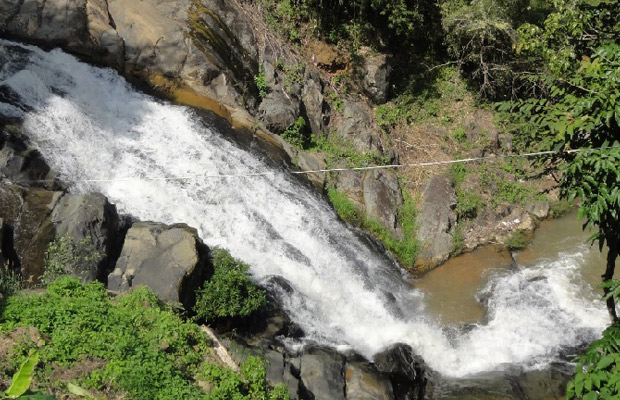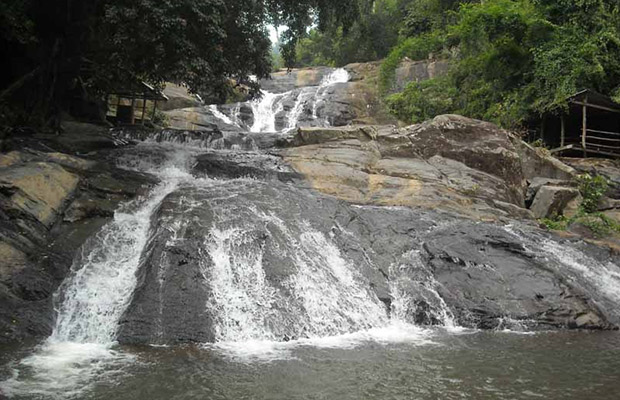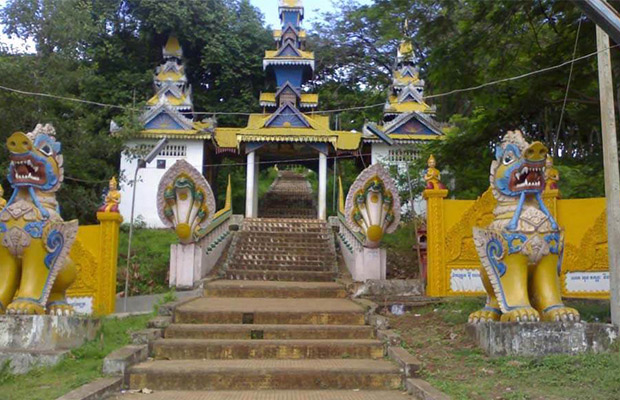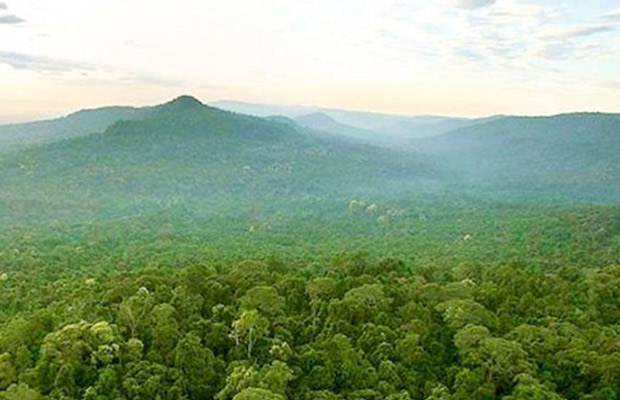Pailin (Khmer: ប៉ៃលិន, Khmer pronunciation: [pai lɨn]) is a province (khaet) in western Cambodia at the northern edge of the Cardamom Mountains near the border of Thailand. This province is surrounded by Battambang Province, and was officially carved out of Battambang to become a separate administrative division after the surrender of the Ieng Sary faction of the Khmer Rouge in 1996. Pailin is known to much of the world for having long been a stronghold of the Khmer Rouge, remaining under their control long after they were defeated in 1979 and serving from 1994 to 1998 as the capital of the "Provisional Government of National Union and National Salvation of Cambodia." Within Cambodia Pailin is known for its natural resources, namely, precious gems and timber.
Once a part of the powerful Khmer Empire, Pailin was conquered in 1558 by the Burmese under Bayinnaung and later ruled by the Siamese (Thai) until 1946 when it was returned to Cambodia. It was known to the Thai as "Phailin" (Thai: ไพลิน, Thai pronunciation: [pʰāj.lin]). There is still a vibrant border crossing point in Pailin. On 22 December 2008, King Norodom Sihamoni signed a Royal Decree that changed the municipalities of Kep, Pailin and Sihanoukville into provinces, as well as adjusting several provincial borders.
Pailin is a small municipality in the West of Cambodia very closed to the border of Thailand. The provincial capital is called Pailin City and is known to much of the world as being the area where many of the Khmer Rouge leaders came from and retreated after their fall. Until the year of 2001 Pailin was part of the Battambang Province, but was then elevated to city status and thus became a province and autonomous zone of its own.
The city was during the 1980s and 1990s a major Khmer Rouge strongpoint and resource centre. Even after the death of their brutal leader Pol Pot in 1998, many Khmer Rouge leaders still remained there. Some of the leaders went into hiding in fear of punishment for their crimes, although other leaders or henchmen lived openly in the province. It is said that almost 70 percent of the area's older men were fighters for the Khmer Rouge, but unfortunately none of the regular fighters have yet been brought to justice.
As of September 2007, Pailin's remaining Khmer Rouge leaders were being rounded up to face justice by an international tribunal, including Khieu Samphan and Nuon Chea. So after years of the governmental dump contemplation regarding the crime of the Khmer Rouge, its time for lasting enlightenment of what has happen.
Poipet is now more and more becoming a boomtown attracting Cambodians from around the country seeking to make their fortune, or at least a better salary than back home. Pailin was the major revenue producer for the Khmer Rouge guerrillas, being a major gem producing area as well as a prime logging area.
While gem production seems to have tapered off a bit, other business opportunities and the lifestyle have attracted prospectors to the town. Up until the surrender deal of Khmer Rouge's number three men, Ieng Sary, in 1996, the townsfolk lived under the strict rules of the KR hierarchy, with little freedom of ex
Pailin is just another Wild West town of Cambodia and like the gold-rush days of California, people seem to be everywhere in the hills sifting through mud puddles and scratching at the dirt, looking to strike it rich with the find of a nice gem. Still, there is more control of some aspects of life than in other areas of Cambodia.
But this seems to have attracted people rather than kept them away. Several people, who had moved to Pailin from Phnom Penh, gave this as the main reason they made the move. They liked the idea that criminals did not enjoy the same impunity that they seem to enjoy in Phnom Penh. The influx of residents from other parts of the country has produced a friendlier Pailin. Nowadays the mixed lot of Pailin residents seem happy to see foreigners coming in for holidays and check the place out, realizing that their presence means that normalcy and revenue are arriving in Pailin.
Even the Vietnamese residents seem to have been accepted, which is truly amazing given the hatred the Khmer Rouge have generally shown them. Pailin is worth checking out. The town is nestled in a beautiful valley with picturesque sunsets over the mountains that separate Cambodia and Thailand close by.
Wat Gohng-Kahng is very famous and features the much-photographed landmark gate of Pailin town that you face as you arrive on the highway from Battambang. This wat is the centre of holiday festivities these days in Pailin and was the scene of the official Pailin reintegration ceremony in 1996, after the Ieng Sary faction of the Khmer Rouge worked out surrender and semi-autonomy deals with the Cambodian government.
In the early 1970s, Pailin was a prosperous town stemming from the extensive gem deposits in the surrounding countryside. Because of its resources, it was one of the first cities invaded by the Khmer Rouge when they began their major offensive against the national government. The city offered no resistance and the Khmer Rouge soldiers were greeted as liberators as they marched into town. At this point, the deposed king had allied himself with the Khmer Rouge and most residents believed that they were fighting to restore him to power. It was not long, though, before most residents were rounded up for a forced march to the countryside to work in rice paddies. Those believed to have connections to the government were killed. The Khmer Rouge used proceeds from mining in the Pailin area to fund their offensive and later their government once they gained national power. When the invading Vietnamese Army ousted them from power, they retreated to Pailin, where many former Khmer Rouge leaders remain today.
Some leaders went into hiding in fear of punishment for their crimes, although other leaders lived openly in the province. As of September 2007, Pailin's remaining Khmer Rouge leaders were being rounded up to face justice by an international tribunal, including Khieu Samphan and Nuon Chea.
Since the war, Pailin suffered an economic decline and failures of local businesses. However, the now politically stable area is seeing a new wave of tourism focused on its ancient temples, natural forests and wildlife, and especially the precious gem market.
Pailin City municipality is the second smallest so-called province in Cambodia with 803 square kilometres. It's located in the West of the country surrounded by Battambang province and bordering Thailand to the West. In the North, the small municipality consists of the typical plain wet area for Cambodia, covering rice fields and other agricultural plantations.
Pailin City itself is located on the foothills of Chuor Phnom Kravanh, an extension of the Kardamom Mountains, which range until here. The South of the municipality is quite hilly and tops with the highest altitude of 1164m. The province also features some smaller rivers coming from the mountain range.
The current population in this municipality is about 35,234 people or 0.25% of the country's total population (14,363,519 person in Cambodia, 2007, provincial government data), with 19,059 male and 16,175 female. The population density is therefore 44 people per square kilometre.
The country has a tropical climate - warm and humid. In the monsoon season, abundant rain allows for the cultivation of a wide variety of crops. This year-round tropical climate makes Cambodia ideal for developing tourism. Travellers need not to fear natural disasters such as erupting volcanoes or earthquakes, and the country is not directly affected by tropical storms.
Climate: Cambodia can be visited throughout the year. However, those plans to travel extensively by road should be avoided the last two months of the rainy season when some countryside roads may be impassable. The average temperature is about 27 degrees Celsius; the minimum temperature is about 16 degrees. December and January are the coolest months, whereas the hottest is April.
General information about the provincial climate:
- Cool season: November- March (22-28c)
- Hot season: March- May (27c -34c)
- Rainy season: May - October (24-32c, with humidity up to 90%.)
The surrounding area of Pailin City was rich in a variety of gemstones which were mined almost clean to support the Khmer Rouge. They also logged the area to create personal wealth with no regard for the effect on the environment. Nowadays all you can find is low-quality, cheap, hand-faceted gemstones at the market in Pailin downtown.
After the exploitation of the natural resources available, the Khmer Rouge invested their money in the Casinos around Pailin. Pailin is located in the most heavily mined area in the world, so especially unaware travellers are cautioned to stay only on marked roads.
Citizens of Pailin will accept Baht, Riels and US dollars, though US dollars are preferred.

Phnom Khiev Waterfall (Blue Mountain), located at Sangkat Steung Kach, Khan Saha Krau about 20 kilometer distance from Pailinn near the border of Thailand among some parts are already been through to ...

Phnom Yat is a cultural and historical site located in Pailin City. It is not a holy place where people come to worship, but also the heart of Pailin City. The mountain is 60 meters high, 700 meters ...

The Otavao Waterfall is located in Khlong Village in Otavao Commune, only 10 Km away from Pailin's City center. The water flowing down the mountain top is pure and fresh and rests in 7 different ...

Phnom Keu is the most accessible of the numerous waterfalls dropping out of the Cardamoms south of Pailin, and has water year-round. To get here, turn right off NH57 1.5km east of Wat Phnom Yat, then ...

About 50 meters from the foot of Phnom Yat is another pagoda, What Rattanak Sopoan. On the walls of the fence surrounding the pagoda is a bas-relief depicting the story of Churning of the Ocean of ...

At the base of Phnom Yat hill, an impressive gate dating to 1968 leads to Wat Khaong Kang, an important centre for Buddhist teaching before the Khmer Rouge madness. The exterior wall is decorated ...

Bah Hoi Village You will pass through an internal refugee camp from different areas of the country that were formerly under khmer Rouge control and are now in the hands of the government. The people ...

Phnom Koy is located in Sangkat Stung Kach, Khan Sala Krao, about 20 kilometers north of Pailin city. Phnom Koy is a national site rich in forest and big lianas. A natural stream flows down this ...
Guest Name: Ms. Lyn
Country: Philippines
City: Manila
N.of Person: 1 pax
Travel date: 23-09-2024
Booked: Ream National Park Kayaking & Boat Trip Day Tour
Tour Style: Beach Break Holiday
Duration: Full Day